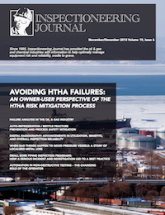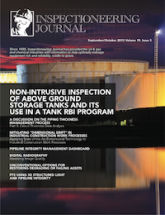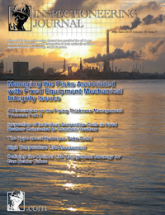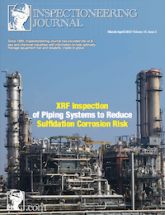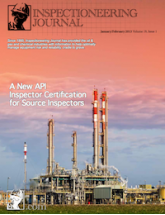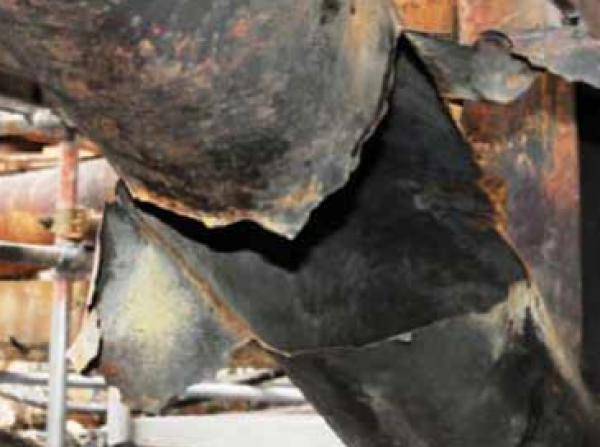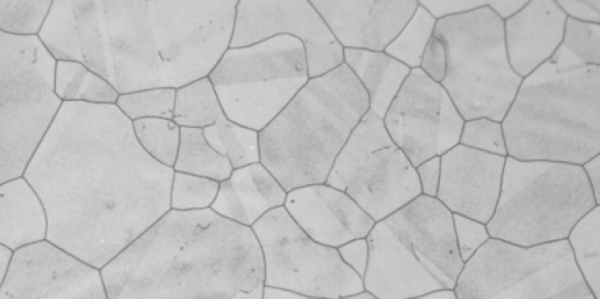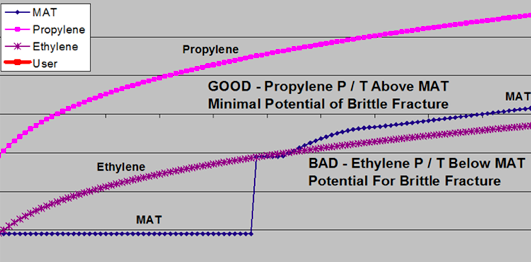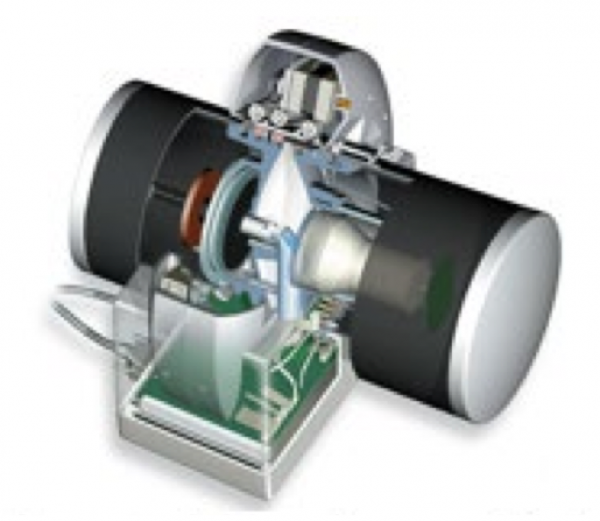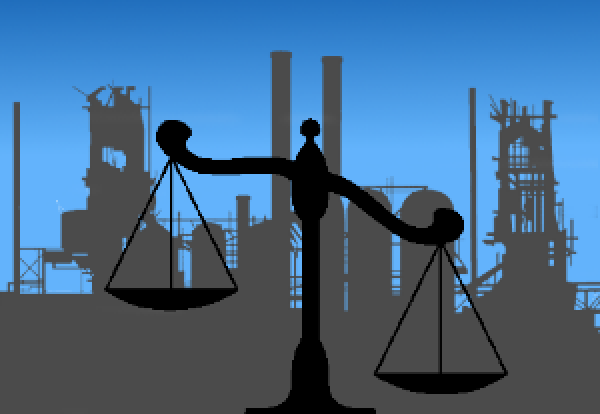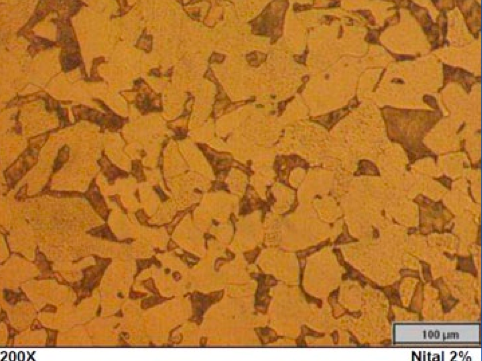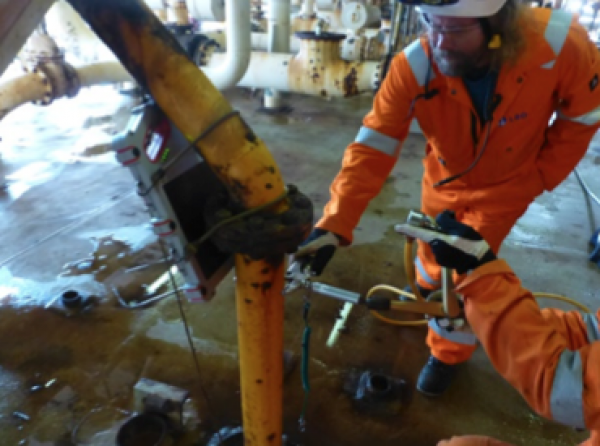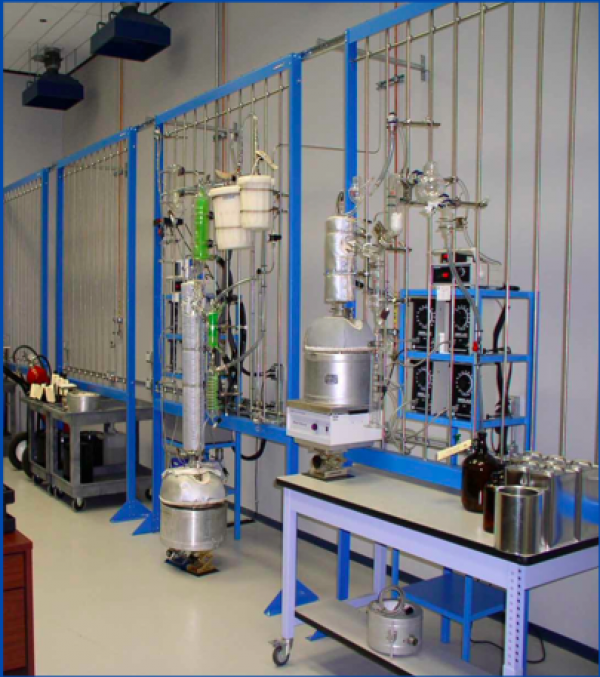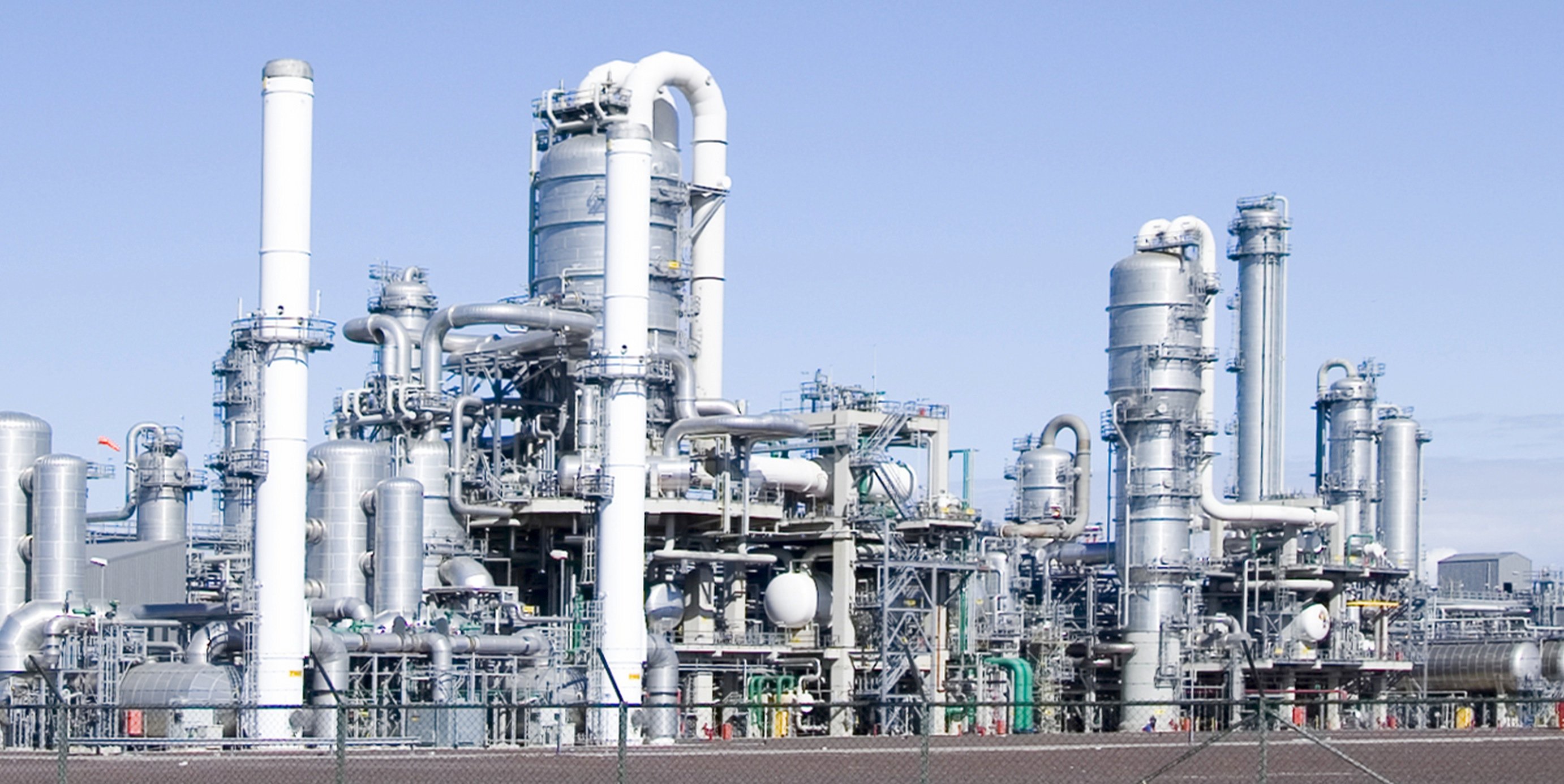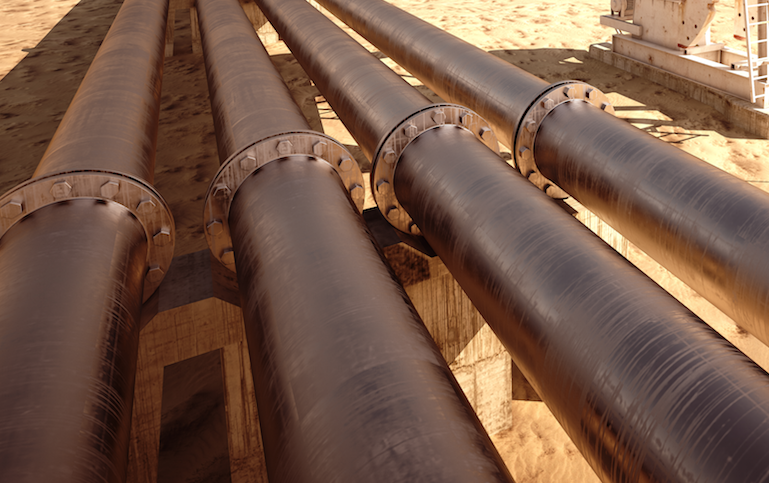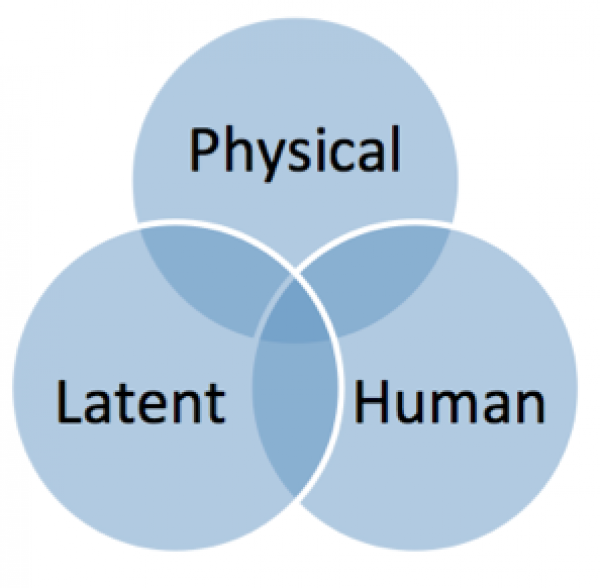Auto-Refrigeration / Brittle Fracture Prevention And Process Safety Mitigation
Automation in Non-Destructive Testing - The Changing Role of the Operator
Avoiding HTHA Failures: An Owner-User Perspective of the HTHA Risk Mitigation Process
Digital Radiography: Advancements in Utilization, Benefits, and Overall Inspection Reliability
Executive Q&A with Tom Wanzeck, Vice President, Integrity Services, Willbros Group, Inc.
Failure Analysis in the Oil & Gas Industry
Industry Remembers the Life and Contributions of Trevor Kletz
When Bad Things Happen to Good Pressure Vessels: A Story of Localized Metal Loss
A Discussion on the Piping Thickness Management Process - Part 5: Circuit Thickness Data Analysis
Compliance: Do you have what it takes?
Digital Radiography - Assessing Image Quality
Executive Q&A with Ryan Sitton, President and CEO, PinnacleAIS
FFS using 3D Structured Light and Pipeline Integrity
Mitigating "Dimensional Drift" in Industrial Construction Work Processes
Non-Intrusive Inspection of Above Ground Storage Tanks and Its Use in a Tank RBI Program
Pipeline Integrity Management Dashboard
Unconventional Options for Restoring Degrading or Failing Assets
Assessing Component Condition using Remote Metallography and Hardness Testing
Common Legal Issues Affecting the Refining Industry
Executive Q&A with Kevin Somers, President, Inspectorate
How to Improve Your Fixed Equipment Mechanical Integrity Program by Managing Your Manager(s)
Non-Contact Ultrasonic Testing with EMAT: In-Service Applications
Tank Inspections per STI SP001 5th Edition
The Challenge of Inspection and Assessment of Critical Piping Systems in Chemical Plants
The Importance of Process Safety Information in Implementing a Mechanical Integrity Program
A Discussion on the Piping Thickness Management Process - Part 4: Collecting Quality Thickness Data
Common Legal Issues Affecting the Refining Industry
Defining the Optimal Life Management Strategy for Gas Heater Tubes
High Temperature Life Assessment
Inspection of Individual Serpentine Coils in Fired Heaters Connected to Common Headers
Managing the Risks Associated with Fixed Equipment Mechanical Integrity Issues
Crude Flexibility Management Threat Awareness
Driving Better AIM Decisions Through Crude Assays
Fitness-for-Service Assessment: Severe Local Corrosion
Integrity Management Programs, KPIs and PSM
Non-Contact Ultrasonic Testing with EMAT: Introduction to EMAT
Safely Operating Steam Reformers between Turnarounds
Transient Computational Fluid Dynamics
XRF Inspection of Piping Systems to Reduce Sulfidation Corrosion Risk
2013 Inspectioneering Journal Article Index
In response to reader feedback, we implemented some important improvements in 2012. As we broaden our scope to include all aspects of Asset Integrity Management, its synergy and leverage become increasingly important. We will sustain this forward...
This article is the third of a series of articles that will focus on one critical sub process within a PEIP that is key in managing the integrity of process piping: thickness monitoring programs for internal corrosion. These articles will discuss...
Piping failures still represent a frustrating and ongoing problem for processing plants. Failures are still commonly reported and contribute to large losses. In the author’s experience, piping represents the highest percentage of fixed equipment...
This article is the fifth of a series of articles that will focus on one critical sub process within a PEIP that is key in managing the integrity of process piping; Thickness Monitoring Programs for Internal Corrosion.
A new API Individual Certification Program (ICP) will be offered soon to certify inspectors who perform quality assurance (QA) surveillance and inspection activities on new materials and equipment for the energy and chemical (E&C) industry. It is...
Remote metallography, in-place metallography, in-situ metallography, and field replication are all examples of typical trade names of this great tool used for assessing the condition of a metal component.
Auto-refrigeration is a process where an unintentional and/or uncontrolled phase change of a hydrocarbon from a liquid state to a vapor occurs, resulting in a very rapid chilling (refrigeration) of the liquid containing local equipment and/or...
To understand the current non-destructive testing (NDT) world, it is perhaps a good idea to look back at things historically. By doing this, changes which have taken place become apparent, and very soon one can conclude that this is actually quite...
A recent High Temperature Hydrogen Attack (HTHA) failure at a refinery in the state of Washington was a “wake up call” to our industry.
Some involvement with legal issues is inevitable for professionals, including individuals and the companies for whom they work. But too often, companies – their management, their personnel, and their counsel – accept the status quo as providing...
As discussed in the May/June issue of Inspectioneering Journal, some involvement with legal issues is inevitable for individuals and companies in the refining, manufacturing, transportation, and energy industries.
It is important for your company to step back, look at its compliance program, and objectively evaluate whether the program has what it takes to effectively detect violations of the law.
Over the past few years increased feedstock flexibility has become a growing reality for sustainability of the refining business, requiring processing of more difficult crudes, increased volumes of spot cargoes, and rapid response to crude...
Industrial furnaces are used extensively throughout the entire oil and gas industry, as well as other process industries such as pulp and paper, metals and mining, chemical, and petrochemical. An industrial furnace, or direct fired heater, is a...
The Modulation Transfer Function (MTF) is used in imaging science to assess the reliability of imaging systems to produce different spatial frequency. In digital radiography, it can be used to detect frequency responses of different inspection...
Over recent years large strides have been made in application, development, and utilization of Digital Detector Arrays (DDAs) in field radiography environments (an application previously limited to film and computed radiography [CR] techniques).
For crude oil refiners and traders, information is the lifeblood of their operations and business decisions. The information obtained by crude oil assays, which includes physical properties and compositional analysis of a crude oil, provides...
I joined Inspectorate in 1988 as Vice President of Gulf Coast Operations in the Oil and Petrochemical Division. I held that role until 1995 when I was appointed Vice President of U.S. operations.
Earlier this year, our friends at Pinnacle Asset Integrity Services hosted a webinar entitled Mechanical Integrity Assessment: Why Bother? The broadcast included discussions on the history and value of asset integrity programs, as well as the...
Inspectioneering recently had the privilege of speaking with Tom Wanzeck, Vice President of Integrity Services with Willbros Group, Inc. Tom spent more than 20 years managing assets on the owner-operator side before making the leap to the service...
Service failures and safety incidents of machines, structures, and pressure equipment have been experienced in the oil and gas industry for many years without warning, with varying degrees of consequential damages to health, safety,...
Even though oil and gas pipelines and their related facilities are generally safer for people and the environment compared to other means of transportation, occasional leaks and failures due to corrosion and other defects have become an issue in...
If an operator finds cracking in a furnace waste heat boiler, excessive thinning in an absorption tower, or severe bulging in a converter, FFS assessments—not standard code analyses—are needed to evaluate the unit’s mechanical...
Predicting the remaining life of components operating in the creep regime is one of the trickiest problems encountered in the fitness-for-service (FFS) world.
IÂ have written numerous technical articles addressing how to improve your fixed equipment mechanical integrity (FEMI) program. This time I will deviate from the FEMI technologies and methodologies to address a topic that may be equally...
Traditional pressure vessel inspections often require taking assets out of service. However, MISTRAS’ Non-Intrusive Inspection (NII) programs provide data as good or better than internal inspections, while assets remain in service. NII is...
Contact us at buddy@dimate.de to learn how DIMATE PACS digitizes NDT methods (RT, UT, VT, ...) and how it leads to paperless inspections.
It is with sadness that I learned of the passing of one of the world’s greatest authorities on chemical process safety, Dr. Trevor Kletz; a man I deeply respected and admired for his commitment to improving safety, preventing accidents, and...
Refineries and chemical plants own and operate numerous process heaters (e.g. gas reformers, CCRs, etc.) as part of the standard assets throughout the facilities. Many heater coil configuration designs are flanged at both ends; however, there are...
A pattern of requests for key performance indicators (KPIs) related to equipment integrity management (IM) programs has appeared on Inspectioneering’s LinkedIn group discussion as well as other industry forums. Furthermore, the topic came up...
In this article you will find the failure investigations of six 0.094 inch thick carbon steel vessels. These vessels were in service in natural gas well facilities; some functioned as dryers and were subjected to cyclic loads. Metallographic tests,...
One of the reasons we continue to have too many fixed equipment mechanical integrity (FEMI) events in the refining and process industries is the lack of understanding and appreciation by site management for the hazards posed by the 101 FEMI issues.
The goal in chemical process design is to produce a plant design that is optimal with respect to cost and performance. Plant performance involves a broad range of criteria.
Non-contact ultrasonic testing with EMAT was formally introduced in part one of this series found in the March/April issue of Inspectioneering Journal. Readers were introduced to the practical advantages of EMAT Ultrasonic Testing.
This is the first in a series of three articles that will introduce Electro Magnetic Acoustic Transducer (EMAT) and its practical applications in the field of nondestructive testing (NDT). EMAT, or Electro Magnetic Acoustic Transducer, is an...
Maintaining the mechanical integrity of above ground storage tanks (AST’s) is the focal point of tank inspection programs. Performing internal inspections is an integral part of a tank integrity program, however, deciding when to take a tank out...
Now, more than ever, pipeline owners and operators are under intense scrutiny to ensure safe and dependable pipeline systems.
The benefits of adding fitness-for-service (FFS) assessments to energy sector reliability projects are numerous. The acceptance of API 579/ASME FFS-1 is increasing across the energy sector and other industries, as these benefits have been...
Steam reformers are critical assets to many refining and chemical manufacturing plants and facilities, and it is well known that the reformer is one of the most challenging assets to maintain and operate. Common problems in reformer operations...
Small bore piping is present in many variations throughout numerous industries. This article will address an incident involving a small bore piping failure that occurred on a 140,000 BPD crude distillation unit in the refining industry.
Lessen downtime by enhancing your plant infrastructure, ensuring mechanical integrity, and extending equipment lifespan. Contact us for on-demand engineering expertise in assessment, problem-solving, specialized testing, and preventative solutions.
Each year about 14,000 oil spills are reported, according to the EPA. It is estimated that there are 618,000 facilities that are regulated under EPA SPCC in the United States.
Inspection and fitness-for-service assessments of critical in-plant piping systems are a concern for the chemical industry. This presents a potentially insurmountable task and discovery of a number of areas where the condition is at risk.
With 30 years of refinery experience, I have been through many turnarounds and been involved with a lot of repairs. When I started in the business, we would have inspectors that “owned” their specific pieces of equipment.
The Process Safety Management Rule (29 CFR 1910.119 - PSM) has long been recognized as a collection of interdependent requirements. In recent reviews of PSM programs by OSHA, it has been shown that two of the most cited elements in agency audits...
Who at your facility owns injection point hardware? Typically, injection point hardware falls into the Gray Zone.
It is another day at the plant and as usual, your boss calls and says there is a meeting in the conference room that he wants you to attend regarding a compressor failure. That is all you know, but from experience you know it must be something major...
Composite repair systems can be a great option for owner/ operators to extend the life of their assets without disrupting operations.
While there are many types of damage mechanisms that can occur in a piece of equipment, localized metal loss is one of the most common. If an inspection reveals that metal loss has occurred, many questions are raised...
Sulfidic corrosion of piping and equipment within the refining industry continues to be a significant cause of leaks and issues that can lead to early replacements, unplanned outages, and incidents potentially resulting in loss of property and...
